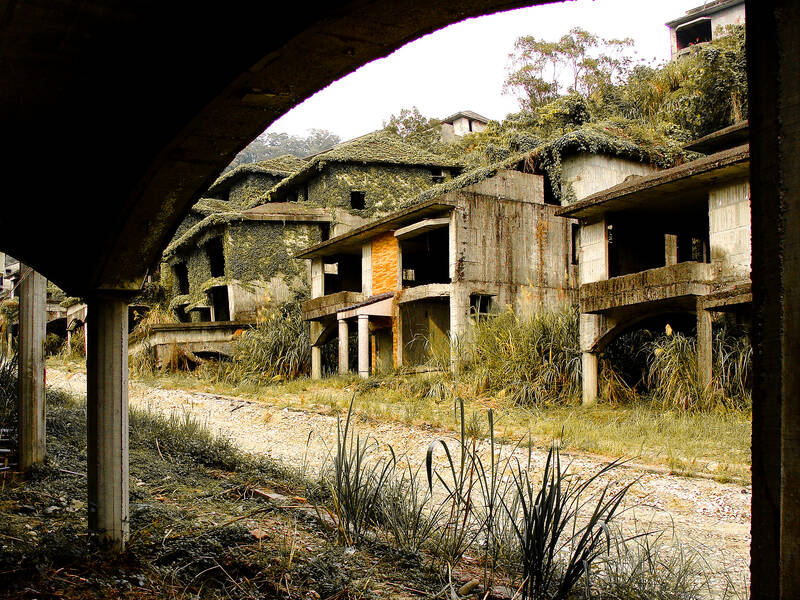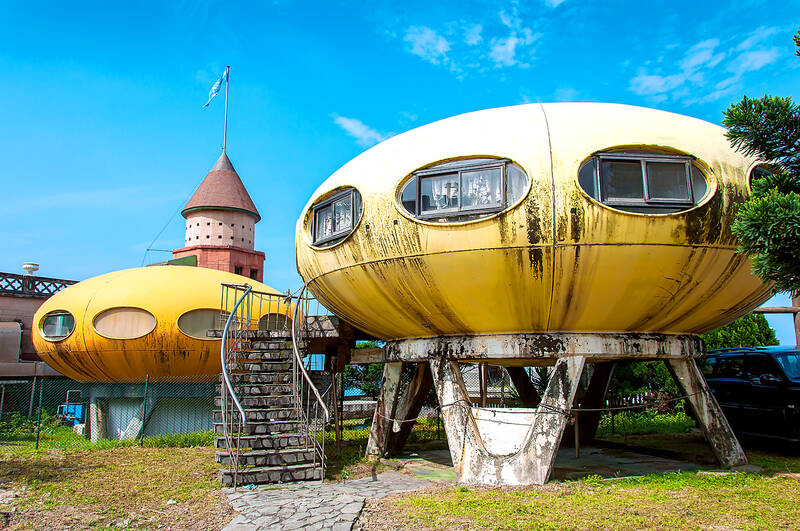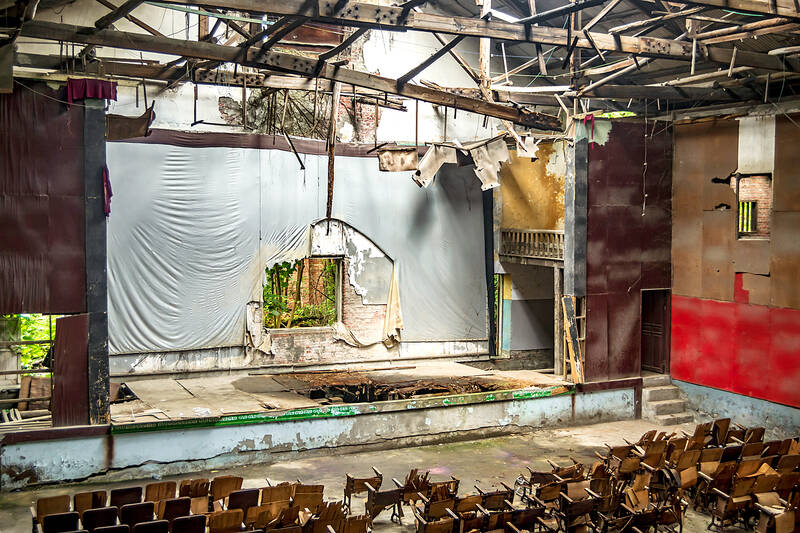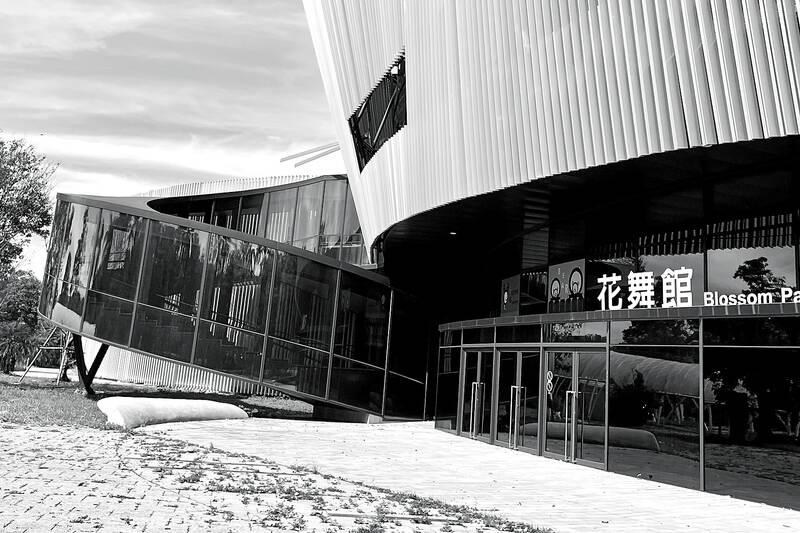On a hillside overlooking Taichung are the remains of a village that never was. Half-formed houses abandoned by investors are slowly succumbing to the elements. Empty, save for the occasional explorer.
Taiwan is full of these places. Factories, malls, hospitals, amusement parks, breweries, housing — all facing an unplanned but inevitable obsolescence.
Urbex, short for urban exploration, is the practice of exploring and often photographing abandoned and derelict buildings. Many urban explorers choose not to disclose the locations of the sites, as a way of preserving the structures and preventing vandalism or looting.

Photo: Kayt Bronnimann
For artist and professor at NTNU and Taipei National University of the Arts, Yao Jui-chung (姚瑞中), photographing abandoned buildings has been a form of collective artistic practice and citizen-led calls for accountability through highlighting the widespread mismanagement of public money.
‘MOSQUITO HALLS’
Dubbing themselves “Lost Society Document,” since 2010 Yao and his students have photographed over 800 derelict ‘mosquito halls’ (蚊子館) — publicly funded buildings and complexes in Taiwan that have since been left vacant.

Photo: Kayt Bronnimann
A surge in election promises following the lifting of martial law led to a frenzy of planning and building of public works.
“A carpark for every town!” “An incinerator for every county!” became the calling cry of different government departments.
Yet within years of opening, many of these projects had closed their doors. Poor planning, mismanagement, lack of local interest and insufficient operational budgets were just some issues befalling them.

Photo courtesy of Alexander Synaptic
The cost of these boondoggles to the public can be staggering. There is the NT$600 million fitness center at Tainan’s Southern Taiwan Science Park (南部科學工業園區), the NT$3.1 billion Linnei Waste Incineration Plant (林內焚化爐) in Yunlin and the astonishing NT$123 billion Changhua Coastal Industrial Park (彰化濱海工業區) — though this latter isn’t fully abandoned.
Published by Lost Society Document over seven volumes, Mirage I-VII: Disused Public Property in Taiwan (海市蜃樓: 台灣閒;置公共設施抽樣踏查), shows empty parking buildings, agricultural parks, harbours, schools, elderly care facilities, retail outlets, waste sites, visitor centres and resorts. They tally the cost of these failed ventures in a most public of audits.
The project drummed up enough controversy to elicit promises from government officials up that these buildings would either be turned into spaces that would serve the public that paid for them or be demolished.

Photo courtesy of Li Xin-yan, Lost Society Document
While the majority of these public works were built between 1995 and 2005, the project, and the problem, is ongoing. A fresh batch of students last year documented 85 idle or underutilized buildings across Taiwan, set to be published in Volume Eight of the series.
Yao said that of the close to 900 mosquito halls that he and his team have documented, 80 percent have been demolished or revitalized.
Taiwan’s history of misplaced architecture is just not confined to more recent history. The industrial imprint of sugar, salt, camphor, mining, tobacco and timber has embedded itself into the landscape of the country and given rise to symbiotic enterprises, such as the entertainment industry.
The geospatial relationship between industry and demographic change is something that attracts Alexander Synaptic, the photographer behind the Web site Spectral Codex. For the past decade he has documented numerous abandoned sites around Taiwan, providing both a visual record and a glimpse into their history.
On a cycling trip around the country in 2013, Synaptic discovered the hulking remains of industry in every small town he visited. Already well versed in urban exploration from his time photographing derelict buildings in Canada’s West Toronto Junction, this trip signaled the beginning of his journey into Taiwan’s abandoned landscape.
After coming across the burnt-out ruins of Taitung’s Datong Theatre (大同戲院), Synaptic learned that, despite its small size, Taitung was once home to 36 traditional theaters. Intrigued by this he delved deeper and has since mapped more than 1000 movie theaters around Taiwan.
Most no longer exist.
A more prescient example of the waning of industry, are the skeletal remains of the Agenna Shipyards (阿根納造船廠遺址) in Keelung.
Throughout the seventies, the Argonaut Corporation manufactured luxury yachts here for Western clientele. But it was not to last. The site passed from company to company and has been abandoned for decades, other than as a backdrop for Instagrammers, posing among the ruins.
Currently the area is sealed off and the whole structure looks ready to tumble. This state of destruction was given a helping hand in 2016 by the company that leases the land. Deeming it unsafe (and uneconomic) they undertook a rogue mini-demolition that was swiftly halted by local government.
There has been talk of designating the shipyards a heritage site, but for now, like many other derelict buildings in Taiwan, they remain in limbo.
FUTURO HOMES
It’s not just industry that has left a mark on the land. Another distinctive and ultimately unsuccessful enterprise lies in New Taipei City’s Wanli District (萬里), home to the world’s highest concentration of Futuro houses.
Intended to be a cheap and compact form of housing, these ovoid structures were the brainchild of Finnish architect Matti Suuronen. Resembling disk-shaped UFOs, they sit suspended above the earth on four legs in Emerald Bay (翡翠灣).
In the 1980s, Su Ming (蘇銘) a Chinese Nationalist civil servant turned soda baron then real estate agent to the American military, brought knockoff versions of the Futuro homes to their current coastal resting place.
His imagined beachside resort never transpired and by the late eighties the project had largely been forsaken by investors and inhabitants alike.
The Futuros have endured and managed to avoid destruction. With dirt on their yellow exteriors some still hold appliances, food and empty beds.
The whole area appears to be cursed, with a large motel complex close by also long since abandoned and awaiting the wrecking ball.
Modernization cares little for preserving the past and many abandoned spaces continue to be demolished. Photographs, therefore, represent an important historical archive, serving as a reminder of what came before.
Yao hopes that a balance can be struck and clear policy articulated when it comes to the expansion of public space and the problem of what to do with Taiwan’s older buildings.
Until that balance is found, empty buildings sit suspended in time and left to the mosquitoes. No longer a something, not quite yet a nothing.

A vaccine to fight dementia? It turns out there may already be one — shots that prevent painful shingles also appear to protect aging brains. A new study found shingles vaccination cut older adults’ risk of developing dementia over the next seven years by 20 percent. The research, published Wednesday in the journal Nature, is part of growing understanding about how many factors influence brain health as we age — and what we can do about it. “It’s a very robust finding,” said lead researcher Pascal Geldsetzer of Stanford University. And “women seem to benefit more,” important as they’re at higher risk of

Last week the Democratic Progressive Party (DPP) said that the budget cuts voted for by the China-aligned parties in the legislature, are intended to force the DPP to hike electricity rates. The public would then blame it for the rate hike. It’s fairly clear that the first part of that is correct. Slashing the budget of state-run Taiwan Power Co (Taipower, 台電) is a move intended to cause discontent with the DPP when electricity rates go up. Taipower’s debt, NT$422.9 billion (US$12.78 billion), is one of the numerous permanent crises created by the nation’s construction-industrial state and the developmentalist mentality it

Experts say that the devastating earthquake in Myanmar on Friday was likely the strongest to hit the country in decades, with disaster modeling suggesting thousands could be dead. Automatic assessments from the US Geological Survey (USGS) said the shallow 7.7-magnitude quake northwest of the central Myanmar city of Sagaing triggered a red alert for shaking-related fatalities and economic losses. “High casualties and extensive damage are probable and the disaster is likely widespread,” it said, locating the epicentre near the central Myanmar city of Mandalay, home to more than a million people. Myanmar’s ruling junta said on Saturday morning that the number killed had

Mother Nature gives and Mother Nature takes away. When it comes to scenic beauty, Hualien was dealt a winning hand. But one year ago today, a 7.2-magnitude earthquake wrecked the county’s number-one tourist attraction, Taroko Gorge in Taroko National Park. Then, in the second half of last year, two typhoons inflicted further damage and disruption. Not surprisingly, for Hualien’s tourist-focused businesses, the twelve months since the earthquake have been more than dismal. Among those who experienced a precipitous drop in customer count are Sofia Chiu (邱心怡) and Monica Lin (林宸伶), co-founders of Karenko Kitchen, which they describe as a space where they